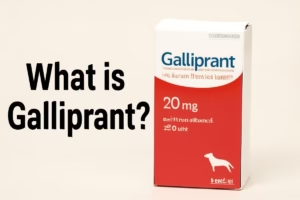Galliprant is a widely used medication for managing osteoarthritis and inflammation in dogs. It’s a popular choice among veterinarians due to its efficacy and relatively mild side effects compared to traditional non-steroidal anti-inflammatory drugs (NSAIDs). However, like all medications, Galliprant can have side effects that some pet owners may be concerned about. One of the more commonly asked questions is: Does Galliprant cause panting?
Panting can be a sign of many different conditions in dogs, ranging from anxiety to medical issues. In this blog post, we will dive into whether does Galliprant cause panting, what other side effects it may have, and how to handle the situation if your dog starts panting more frequently after starting the medication.
What is Galliprant?
Galliprant for dogs is a newer type of medication specifically designed to treat pain and inflammation associated with osteoarthritis in dogs. Osteoarthritis is a chronic, degenerative joint disease that affects many older dogs and can cause severe pain and stiffness. Traditionally, veterinarians have used NSAIDs like carprofen and meloxicam to manage the symptoms of osteoarthritis in dogs. However, these medications can come with a range of Galliprant side effects in dogs, including gastrointestinal issues such as vomiting and diarrhea.For example, Carprofen is a commonly used NSAID for pain relief.

Galliprant, on the other hand, works by blocking the EP4 receptor in the body, which is primarily involved in inflammation. This selective inhibition results in reduced inflammation and pain while causing fewer side effects than other NSAIDs.
While Galliprant is effective at controlling pain, many pet owners are concerned about its side effects, particularly the possibility of Galliprant causing panting in dogs. To answer this question, it’s important to understand what panting typically indicates in dogs and how Galliprant might play a role.
Common Side Effects of Galliprant
Before we explore whether Galliprant causes panting, it’s important to first review the most commonly reported side effects of this medication. Understanding these side effects will help put panting in context, as it may not always be linked directly to the medication itself.

Some common Galliprant side effects for dogs include:
-
Diarrhea: One of the most common side effects observed in dogs taking Galliprant. The gastrointestinal system can be sensitive to new medications, and this can result in some mild discomfort like loose stools.’
-
Vomiting: Another potential side effect of Galliprant, though it is less common than diarrhea. Vomiting may occur when the dog’s stomach reacts to the medication.
-
Lethargy: Some dogs may become a bit more tired or sluggish when starting Galliprant, especially in the initial stages of treatment. This can be a temporary effect as the body adjusts to the medication.
-
Loss of Appetite: As with any medication, some dogs may experience a decreased interest in food. This could be due to mild stomach upset or simply a temporary side effect.
While these side effects are relatively common, panting does not generally appear as a direct or common side effect of Galliprant. However, every dog is different, and some dogs may exhibit panting due to indirect reasons. This brings us to the next section: Does Galliprant cause panting?
Does Galliprant Cause Panting? Understanding the Link
The main question pet owners have is whether Galliprant causes panting. Panting is a common behavior in dogs, and it can occur for many reasons, such as physical exertion, stress, anxiety, heat, or pain. Panting itself is not typically a direct side effect of Galliprant, but there are a few indirect factors that could explain why your dog might start panting more frequently after starting this medication.
1. Pain Relief and Increased Activity
One potential reason your dog may pant more after taking Galliprant is the relief of pain associated with osteoarthritis. Galliprant works by reducing inflammation and alleviating the pain caused by joint degeneration. As the pain lessens, your dog may become more active or mobile, which can lead to increased panting, especially if they’ve been restricted in movement due to pain.
For example, if your dog has been struggling with stiff joints and limited mobility, they may be hesitant to engage in activities they once enjoyed. After starting Galliprant, they might feel more comfortable moving around and playing, which could lead to panting as a normal reaction to physical activity. This is especially true if the activity level has significantly increased after the medication starts working.
or more information on arthritis medications for dogs, you can refer to this helpful article on The Best Arthritis Medicine for Dogs.
2. Stress or Anxiety Due to Medication
It’s also possible that the introduction of Galliprant could cause some level of stress or anxiety in your dog. Some dogs are particularly sensitive to changes in their routine or new medications. The anxiety caused by this change can manifest as panting in dogs.
This is especially common in dogs who are sensitive to medication changes or who have a history of anxiety-related behaviors. Panting can be a sign of nervousness, and if your dog is acting anxious after starting Galliprant, this could explain the increased panting. You may notice other signs of anxiety, such as restlessness, pacing, or even a decrease in appetite.
If you’re concerned about anxiety and medication effects, you can learn more about Pregabalin for Dogs and how it might relate to behavioral changes.
3. Underlying Health Conditions
Panting can also be a symptom of other underlying health conditions that may not be directly related to Galliprant itself. For example, if your dog has an undiagnosed heart issue, respiratory problems, or other medical concerns, panting could be a sign of these conditions rather than the medication.
It’s important to monitor your dog closely for other signs of distress, such as coughing, heavy breathing, or unusual lethargy. If you notice these symptoms alongside the panting, you should consult your veterinarian immediately to rule out any serious conditions that might require different treatment or adjustments to the medication.
If you’re interested in learning more about NSAID use in pets with pre-existing conditions, check out this article on Can Dogs Take NSAIDs for Pain?.
When to Be Concerned About Panting After Galliprant
While panting is often a normal behavior, there are certain situations where panting in dogs could be a cause for concern. If your dog begins panting excessively after starting Galliprant, it’s essential to pay attention to the context and other symptoms.

What to Look For
Excessive panting is defined as panting that occurs at a higher rate than usual or continues for a prolonged period. If your dog’s panting seems out of the ordinary, or if it is accompanied by any of the following symptoms, you should reach out to your veterinarian:
-
Difficulty Breathing: If your dog is panting heavily and seems to be struggling to breathe, this could be a sign of respiratory distress or a heart issue.
-
Lethargy or Disorientation: If the panting is accompanied by unusual tiredness, confusion, or a lack of coordination, it could indicate a side effect of the medication or an underlying health issue.
-
Loss of Appetite or Vomiting: If your dog is panting excessively and also refusing food or vomiting, this could be a sign of gastrointestinal upset or more serious adverse reactions to Galliprant.
-
Changes in Behavior: Any sudden behavioral changes, such as aggression, anxiety, or irritability, could indicate a reaction to Galliprant or another underlying health concern.
For more on other medications and their side effects, feel free to read about Vetoryl for Dogs and how they can impact your pet.
What to Do if Your Dog Pants Excessively
If you observe excessive panting, here are the steps you should take:
-
Monitor Your Dog Closely: Keep track of the frequency and intensity of the panting. Is it persistent, or does it seem to coincide with specific activities or times of day?
-
Consult Your Veterinarian: If the panting is excessive or accompanied by other concerning symptoms, it’s time to consult your veterinarian. They may need to adjust your dog’s medication, check for other health issues, or explore alternative treatments.
-
Ensure a Comfortable Environment: Make sure your dog is in a cool, calm, and quiet environment. Offer plenty of fresh water and a place to relax, especially if anxiety or stress is contributing to the panting.
Does Galliprant Cause Panting in Dogs with Other Health Issues?
If your dog has pre-existing health issues such as heart disease, respiratory problems, or obesity, you may notice that panting is more prominent. Galliprant for dogs dosage may not be the cause of panting in these situations, but it is important to consider how these underlying conditions might be interacting with the medication.

For instance, dogs with heart disease or respiratory issues might already pant more frequently, and the added effect of Galliprant neurological side effects could potentially make this worse. In such cases, your veterinarian may need to adjust the medication to avoid exacerbating these issues.
Alternatives to Galliprant
If you find that Galliprant for dogs is not a good fit for your pet due to side effects like panting, there are alternatives available. Some of these alternatives include:
-
Carprofen: A commonly used NSAID for pain management in dogs with osteoarthritis.
-
Meloxicam: Another NSAID that is often prescribed for pain and inflammation in dogs.
-
Adequan: An injectable treatment that can help with joint health and reduce pain and inflammation without many of the gastrointestinal side effects.
Conclusion: Does Galliprant Cause Panting? What You Should Know
In conclusion, does Galliprant cause panting? While panting is not typically listed as a common side effect of Galliprant, it can occur due to a variety of indirect factors such as pain relief, anxiety, or pre-existing health issues. Galliprant for dogs side effects can vary, and panting may be a symptom that warrants attention, especially if it’s accompanied by other concerning signs like difficulty breathing, lethargy, or vomiting.
As a pet owner, it’s essential to stay vigilant and monitor your dog’s behavior after starting any new medication. If you notice excessive panting or other troubling symptoms, don’t hesitate to consult your veterinarian for advice and potential adjustments to the treatment plan. By staying informed about Galliprant dosage, side effects, and alternatives, you can ensure your dog stays happy and healthy throughout their treatment.
For more insights on medication alternatives, you can visit articles like Sulfasalazine for Dogs: A Game Changer for Pain Relief, or explore Clindamycin for Dogs at the provided links.
References:
https://www.goodrx.com/pet-health/dog/galliprant-for-dogs


